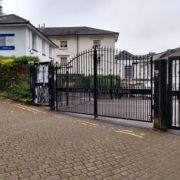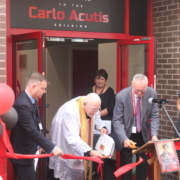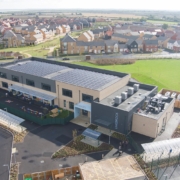The latest programme of school infrastructure improvements worth £8.6 million has been unveiled by Nottinghamshire County Council
The investment is part of the council’s annual school building improvement work which will be designed and delivered by Arc Partnership, a joint venture between the council and SCAPE.
A dozen schools will benefit from a range of improvements, dependent on the needs for each school. The works will include roof replacements, drainage improvements as well as energy-efficient lighting and boiler upgrades.
Cabinet Member for Economic Development and Asset Management, Councillor Keith Girling, said:
“Investing in our schools’ infrastructure is vital. Young people deserve to study and learn in buildings which are fit-for-purpose.
“We know that some schools were impacted by flooding earlier this year, so those schools most in need of improvements to their drainage systems are being prioritised. We have also secured some government money to help towards this work.
“This latest programme of work will once again help school buildings be more energy efficient and help save on bills. It is all part of a long-term investment plan which has seen various improvements to 67 school buildings since 2021.
“Once again, the vast majority of this work will be carried out by local contractors, which is good news for the local economy.”
Councillor Sam Smith, Cabinet Member for Education and SEND, who alongside the Council Leader Ben Bradley, recently wrote to the Department for Education to get reassurance to its commitment to fund the council’s school rebuilding programme. He added,
“This annual programme to improve school buildings is an important investment in our children’s future.”
While the council has a duty to maintain school infrastructure, the day-to-day maintenance tasks are the responsibility of the respective schools. This collaborative approach helps to ensure that schools can address immediate maintenance needs and allow the council to focus on larger infrastructure projects and improvements.
Planned improvements for 2024/5 includes:
James Peacock Infant school in Ruddington. The school will benefit from work worth more than £1.04 million to upgrade the building’s infrastructure and help improve energy efficiency. This will include new ceilings and lighting, replacing the flat roof covering and insulation and the external cladding. (This is additional funding/works to what has been approved in previous years).
Pierrepont Gamston school will have two sets of improvements: Replacing the roof covering and improve insulation (£250,000) Replace old boiler with an energy efficient one (£205,000)
Woods Church of England Foundation Primary, Woodborough will have £549,000 worth of work to have gas boilers replaced with high efficiency modern equivalent. All heaters and pipework will also be replaced. This is additional funding/works to what had been approved in previous years.
Manor Park Infant and Nursery in Calverton will have £100,000 worth of work will include structural inspection of the floors in a number of classrooms with remedial works as necessary.
Pinewood Infant and Nursery, Killisick will have its roof covering replaced and other work to improve insulation. (£586,000)
Walkeringham Primary in the Bassetlaw area will have £160K worth of works to improve its drainage system after suffering from flooding earlier this year by using the latest techniques to mimic natural drainage, known as sustainable urban drainage
North Wheatley school, near Retford will have similar sustainable urban drainage works after also being impacted by recent flooding, as part of a £170,000 investment.
Berry Hill Primary and Nursery in Mansfield will see a £2.33 million investment to replace roof covering and improved insulation. The ceiling will be replaced as well as improvements to ceiling tiles, lighting, fire alarm systems.
High Oakham Primary in Mansfield will have its pitched roof replaced at a cost of £2.5 million. The work will also include replacement of ceiling, including works to ceiling tiles, Lighting, fire alarm systems and incorporating works identified through the site risk assessments.
Underwood Church of England Primary, Underwood will have £224,310 worth of work to identify and carry out remedial works to rectify water leaks to the Learning Lodge.
Jacksdale Primary and Nursery, Jacksdale, near Selston will have £62,500 invested to install new pumps to the basement to remove standing water and help prevent future flooding.
Maun Infant and Nursery in New Ollerton, £135,000 worth of work will help improve parts of an old drainage system plus replace internal rainwater pipes.
Source: Nottinghamshire County Council










